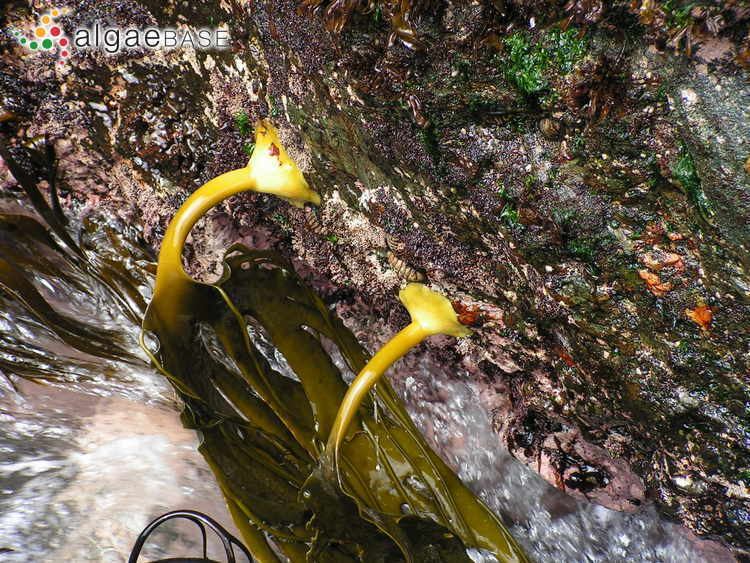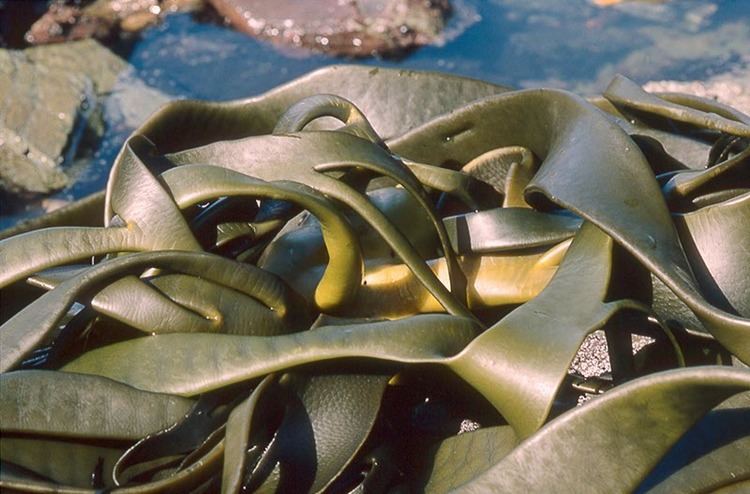Superphylum Heterokonta Family Durvillaeaceae Scientific name Durvillaea antarctica Rank Species | Order Fucales Genus Durvillaea Higher classification Durvillaea | |
 | ||
Similar Durvillaea, Brown algae, Macrocystis pyrifera, Macrocystis, Lessonia | ||
Durvillaea antarctica, commonly known as cochayuyo, is a large, robust bull kelp species and the dominant seaweed in southern New Zealand and Chile. D. antarctica has a circumpolar distribution between the latitudes of 29°S (in Chile) and 55°S (on Macquarie Island). It is found on exposed shores, especially in the northern parts of its range, and attaches itself with a strong holdfast. D. antarctica, an alga, does not have air bladders, but floats due to a unique honeycomb structure within the alga's blades, which also helps the kelp avoid being damaged by the strong waves.
Contents

Morphology

The blades of Durvillaea antarctica are green to golden brown with a leathery texture. The honeycomb structure of the blade gives strength and buoyancy. This novel structure is thought to be responsible for the wide distribution of this genus, as the kelp is able to float when its holdfast fails. It can colonise other coastlines in this manner, and has been shown to carry communities of invertebrates across vast ocean distances from one shore to another. It is thought that this 'rafting' with Durvillaea antarctica and other floating seaweeds allowed a wide range of species to recolonise sub-Antarctic shores scoured clean by ice during the last Ice Age.

The holdfast of D. antarctica is large and is very difficult to remove. D. antarctica has to resist forces equivalent to 1100 km/h on land. The holdfast failing is usually the result of worms and molluscs which feed on the tissue because of the sheltered habitat it creates. It is also common for its host rock to be broken off without the holdfast losing its grip, with this contributing significantly to erosion in some areas. Recruitment rates of this species is very low, therefore the ecological impact of harvesting this species is too great.
Life cycle
Durvillaea antarctica reproduces sexually by producing egg and sperm that are released into the water. Eggs and sperm are produced on specific sites of the frond. A large individual can produce 100 million eggs in twelve hours. The season when reproduction occurs varies with location, but is generally during winter months.
Use in cuisine
In Chilean Cuisine, the Durvillaea antarctica (Quechua: cochayuyo : Cocha: Lake, and yuyo: weed) stem and holdfast, known as hulte is used for different recipes, like salads and stews.
Expression
The expression remojar el cochayuyo (lit. to soak the cochayuyo) is used in Chilean Spanish to refer to sexual intercourse. The expression derives from the fact that this algae, that is harvested along Chile's coast, is preserved by being sun-dried and to prepare it then in a dish it needs to be softened up by being soaked in water.
Taxonomy
The species was first described in 1822, as Fucus antarcticus, and revised in 1892 as Durvillaea antarctica. The genus name Durvillaea was given in memory of the French explorer Jules Dumont d'Urville, while the Latin derived epithet refers to antarctic. Recently, taxonomic revision led to the recognition of a new species, Durvillaea poha, within what was previously considered Durvillaea antarctica. Durvillaea poha is the only other species in the genus to share the honeycombed structure and buoyancy of D. antarctica. D. poha occurs only in southern New Zealand and on some New Zealand islands (including the Auckland and Snares Islands), whereas D. antarctica has a wider distribution, and is found around New Zealand, Chile and the sub-Antarctic islands. In southern New Zealand, D. poha and D. antarctica can be found growing together, although D. poha normally grows higher up or further back on the rock platforms, or in more sheltered bays, where wave force is weaker. D. poha generally has wider fronds than D. antarctica, and can appear more 'orange' across the frond area.
